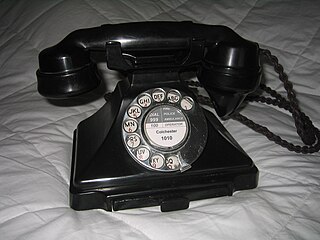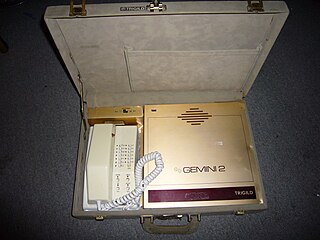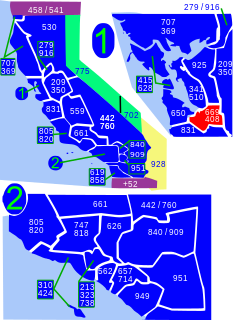Related Research Articles
The erlang is a dimensionless unit that is used in telephony as a measure of offered load or carried load on service-providing elements such as telephone circuits or telephone switching equipment. A single cord circuit has the capacity to be used for 60 minutes in one hour. Full utilization of that capacity, 60 minutes of traffic, constitutes 1 erlang.

Throughout the 20th century, telephone switchboards were devices used to connect circuits of telephones to establish telephone calls between users and/or other switchboards. The switchboard was an essential component of a manual telephone exchange, and was operated by switchboard operators who used electrical cords or switches to establish the connections.
In telecommunication engineering, and in particular teletraffic engineering, the quality of voice service is specified by two measures: the grade of service (GoS) and the quality of service (QoS).
Phreaking is a slang term coined to describe the activity of a culture of people who study, experiment with, or explore telecommunication systems, such as equipment and systems connected to public telephone networks. The term phreak is a sensational spelling of the word freak with the ph- from phone, and may also refer to the use of various audio frequencies to manipulate a phone system. Phreak, phreaker, or phone phreak are names used for and by individuals who participate in phreaking.

Most public switched telephone networks have a single emergency telephone number that allows a caller to contact local emergency services for assistance. The emergency number differs from country to country; it is typically a three-digit number so that it can be easily remembered and dialed quickly. Some countries have a different emergency number for each of the different emergency services; these often differ only by the last digit.
A dial tone is a telephony signal sent by a telephone exchange or private branch exchange (PBX) to a terminating device, such as a telephone, when an off-hook condition is detected. It indicates that the exchange is working and is ready to initiate a telephone call. The tone stops when the first dialed digit is recognized. If no digits are forthcoming, the partial dial procedure is invoked, often eliciting a special information tone and an intercept message, followed by the off-hook tone, requiring the caller to hang up and redial.

The North American Numbering Plan (NANP) is a telephone numbering plan for World Zone 1, which comprises twenty-five distinct regions in twenty countries primarily in North America, including the Caribbean. Some North American countries, most notably Mexico, do not participate in the NANP.

A telephone call is a connection over a telephone network between the called party and the calling party.
Call forwarding, or call diversion, is a telephony feature of some telephone switching systems which redirects a telephone call to another destination, which may be, for example, a mobile or another telephone number where the desired called party is available. Call forwarding was invented by Ernest J. Bonanno. In North America, the forwarded line usually rings once to remind the customer using call forwarding that the call is being redirected. More consistently, the forwarded line indicates its condition by stutter dial tone. Call forwarding typically can redirect incoming calls to any other domestic telephone number, but the owner of the forwarded line must pay any toll charges for forwarded calls. Call forwarding is often enabled by dialing *72 followed by the telephone number to which calls should be forwarded. Once someone answers, call forwarding is in effect. If no one answers or the line is busy, the dialing sequence must be repeated to effect call forwarding. Call forwarding is disabled by dialing *73. This feature requires a subscription from the telephone company. Also available in some areas is Remote Access to call forwarding, which permit the control over call forwarding from telephones other than the subscriber's telephone. VOIP and cable telephone systems also often allow call forwarding to be set up and directed via their web portals.

The director telephone system was a development of the Strowger or step-by-step (SXS) switching system used in London and five other large cities in the UK from the 1920s to the 1970s.

The Improved Mobile Telephone Service (IMTS) was a pre-cellular VHF/UHF radio system which linked to the public telephone network. IMTS was the radiotelephone equivalent of land dial phone service. Introduced in 1964, it replaced Mobile Telephone Service (MTS) and improved on most MTS systems by offering direct-dial rather than connections through a live operator, and full-duplex operation so both parties could talk at the same time.
Global System for Mobile Communications (GSM) services are a standard collection of applications and features available to mobile phone subscribers all over the world. The GSM standards are defined by the 3GPP collaboration and implemented in hardware and software by equipment manufacturers and mobile phone operators. The common standard makes it possible to use the same phones with different companies' services, or even roam into different countries. GSM is the world's most dominant mobile phone standard.
Telecommunications traffic engineering, teletraffic engineering, or traffic engineering is the application of traffic engineering theory to telecommunications. Teletraffic engineers use their knowledge of statistics including queuing theory, the nature of traffic, their practical models, their measurements and simulations to make predictions and to plan telecommunication networks such as a telephone network or the Internet. These tools and knowledge help provide reliable service at lower cost.
Network planning and design is an iterative process, encompassing topological design, network-synthesis, and network-realization, and is aimed at ensuring that a new telecommunications network or service meets the needs of the subscriber and operator. The process can be tailored according to each new network or service.
An intercept message is a telephone recording informing the caller that the call cannot be completed, for any of a number of reasons ranging from local congestion, to disconnection of the destination phone, number dial errors or network trouble along the route.
Dispatch is a procedure for assigning employees (workers) or vehicles to customers. Industries that dispatch include taxicabs, couriers, emergency services, as well as home and commercial services such as maid services, plumbing, HVAC, pest control and electricians.

Area codes 408 and 669 are telephone area codes in the North American Numbering Plan (NANP) in the U.S. state of California. The numbering plan area comprises most of Santa Clara County and Northern Santa Cruz County, and includes Gilroy, Morgan Hill, Saratoga, Los Gatos, Monte Sereno, Milpitas, Sunnyvale, Santa Clara, Cupertino, Campbell, and San Jose.
In telecommunications, busy-hour call attempts (BHCA) is a teletraffic engineering measurement used to evaluate and plan capacity for telephone networks. BHCA is the number of telephone calls attempted at the sliding 60-minute period during which occurs the maximum total traffic load in a given 24-hour period (BHCA), and the higher the BHCA, the higher the stress on the network processors. BHCA is not to be confused with busy hour call completion (BHCC) which measures the throughput capacity of the network. If a bottleneck in the network exists with a capacity lower than the estimated BHCA, then congestion will occur resulting in many failed calls and customer dissatisfaction.
The eighty six original NANP area codes were established in 1947 in the initial configuration of the North American Numbering Plan (NANP). The NANP was developed by the American Telephone & Telegraph Company (AT&T) in the immediate post-WWII period to create a uniform destination addressing and call routing system for telephone networks on the North American continent. For the purpose of administration and telephone call routing, the content was divided into numbering plan areas (NPAs) that principally followed existing U.S. state or Canadian provincial boundaries, but fifteen states and provinces were subdivided further, creating 46 NPAs. Forty NPAs were assigned to entire states or provinces.

A telephone exchange or telephone switch is a telecommunications system used in the public switched telephone network or in large enterprises. It interconnects telephone subscriber lines or virtual circuits of digital systems to establish telephone calls between subscribers.
References
- ↑ See How to Do Call Volume Forecasting for Service Desks Archived 2007-11-04 at the Wayback Machine
| This article related to telecommunications is a stub. You can help Wikipedia by expanding it. |